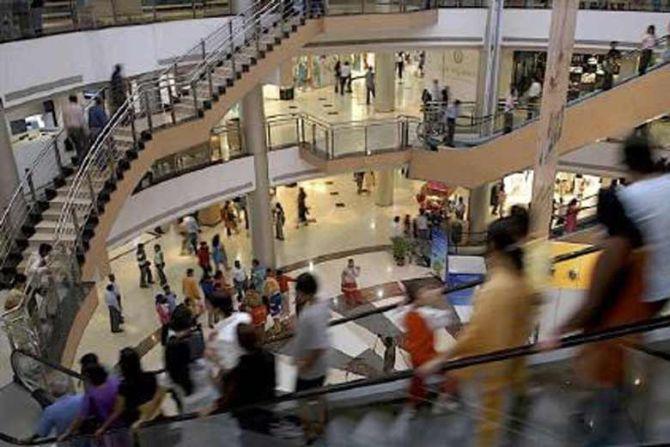'If credit is not available, people will postpone buying. That's what has happened.'

Bad news continues to flow about the Indian economy, the latest being the GDP growth slipping to 5% for the quarter ending June 2019.
Though the Rashtriya Swayamsevak Sangh-affiliated Swadeshi Jaagran Manch has been critical of the government's FDI policy and the withdrawal of the surcharge on income tax on foreign portfolio investment, SJM Co-convenor Dr Ashwani Mahajan, professor of economics at Delhi University, believes the economic situation is not alarming.
"I don't see any recession though there is a slowdown," Dr Mahajan tells Rediff.com's Shobha Warrier.
Do you feel what the Indian economy is going through is unprecedented?
The question is, how do you measure the slowdown in an economy? One is, you can do it by looking at the demand for consumer goods. I have found that almost all the FMCG companies are showing a sales growth of 10% or above while some companies showed around 5%.
Big Bazaar, Colgate-Palmolive, P&G are all showing growth in sales.
If you look at consumer durables like air-conditioners, washing machines, refrigerators also, you see growth in sales.
Parle G was said to be laying off 10,000 people...
A big company like Hindustan Lever employs not more than 35,000 people! How can a small company like Parle G employ one lakh people and lay off 10,000? They made it clear that it was blown out of proportion and what was reported was not true.
Interestingly, another news item said there was a growth in the sales of cookies, but slowdown in biscuits!
My thesis is that there is less of a slowdown and more of a distribution problem.
For example, the rich are demanding more while the poor cannot afford many things. That cements our theory that inequality is on the rise after globalisation.
I feel the media has overblown the economic situation without any sound ground. Consumer demand for consumer durables is rising. Yes, the problem is with the auto sector.
When representatives of the automobile sector met the Swadeshi Jagran Manch, they were not of the opinion that it was because of the economic slowdown that they were suffering. They clearly stated in their representation to the finance minister and Swadeshi Jagran Manch that it was the cost and availability of credit that had affected the sector.
How did this happen? Inflation is down across the board right now. When inflation is down, business sentiments get impacted adversely.
If the inflation is around 5%-6%, it is an incentive for manufacturers to produce more so that they can sell at a higher price in the subsequent period. Therefore, some degree of inflation leads to some degree of incentivisation for manufacturers to produce more.
At a time like this, it is the duty of the Reserve Bank to lower the rate of interest so that there is an incentive to invest more, and also buy more.
The consumers of the auto industry buy on credit, mainly through the NBFCs (non-banking financial companies). Now, because of the IL&FS crisis, banks stopped re-financing the NBFCs. So, they started facing a liquidity crisis.
On one side, because of the NPA problem, banks were lending less. NBFCs also stopped lending. And people do not purchase automobiles by spending money from their pockets.
Some 95% of the purchase of automobiles is done on credit. If credit is not available, people will postpone buying. That's what has happened.
So, the economic ecosystem in India is bank-based. So, it is necessary to look into the problem of banks and the NBFC sector urgently. This is also a legacy.
Is it not time to solve the problem of NPAs?
It was a problem bigger than many expected.
Still, in the last five years, bank loans increased by four times. While the UPA tried to hide the problem, the Modi government perceived the problem and came up with solutions.
IBC (the Insolvency and Bankruptcy Code) was a major step. In fact, that was the turning point. After that, many people who were not ready to repay, came forward to pay the money back.
How long do you think the NPA problem will continue?
The NPA problem has already started receding. I don't see any reports that say NPAs are rising.
But the lending cycle has not yet started...
When the NPA problem was getting sorted out, a new problem of IL&FS came in. It was a bigger problem as the amount involved was very high. In order to save themselves, banks stopped financing NBFCs. That was how the problem of the automobile sector arose.
Consumer durable sales did not get affected because they were purchased on credit cards. But automobiles are not sold on credit cards.
Two more reasons are there behind the auto sector slowdown. One is the push given by the government to electric vehicles. Another reason is the emergence of taxi services.
So, the problems the auto sector facing is unique. I also would say the problem will not last very long.
Would you say the crisis in the Indian economy is mainly due to the problems in the auto sector?
You have to realise that the automobile sector is an important sector contributing a great extent to manufacturing in this country. This sector has many other sectors connected to it like the component manufacturers, distribution networks, etc.
Now that you have identified the problem, what you have to do is find solutions. It is not that we are groping in the dark about the problem.
Will the RBI's move to transfer Rs 1.76 lakh crores to the government help revive the economy?
I have been saying this from the very beginning that the profits and surplus with the RBI belong to the government. The government is the owner of the central bank which is not unique to India; it is the same everywhere.
If the profits and surpluses of the central bank are not transferred to the government, they would be the richest institutions in the world!
In the last few years, the non-transfer of profits by the RBI, have had an impact on the spending of the government. If you look at the Budgets of the last 20 years, you will find that a big portion of the government spending came from the RBI.
The norm in economics is that whenever there is a growth in the economy, you need more money to be printed, more money to be circulated and that money comes from the central bank.
Therefore, any surplus generated by the central bank belongs to society, and the government represents society as money cannot be transferred to you or me.
And the money transferred by the RBI is not going to the accounts of Narendra Modi or Amit Shah. It is going to the government that is starved of money because of the RBI mismanagement in previous years.
I have said to you earlier also that the whole idea of the RBI autonomy is weird. It can be autonomous in its functioning and decision-making, but not in the established norms.
Can the transfer of Rs 1.76 lakh crores change the mood of the economy?
You have to understand that there was a revenue shortfall of Rs 1.76 lakh crores and because of that, the government expenditure had shrunk. And the shrinking was also due to the non-transfer of the profits by the RBI.
Now, we need to increase government expenditure and this transfer will definitely help in it.
What we need now is an increase in demand. Both demand and supply are important in an economy. Affordable lending is necessary to increase demand and it is the RBI's duty to reduce the rate of interest.
Investment demand is affected by the rate of interest. So, the rate of interest must be reduced to encourage people to borrow and invest more.
You must also understand that money to the tune of Rs 15 lakh crores is lying with private corporates. but they are not investing.
They say they have no confidence in investing. What they are doing is they are investing in the bond market at the rate of 7%-8%. They feel their money is growing because of the high rate of interest.
My question is, if there is no confidence, why is FDI coming to India?
The government has now come up with big FDI moves in single brand retail, digital media and manufacturing sector to boost the economy. You have always been against FDI...
I have always said that FDI and foreign portfolio investment are not the panacea for all the economic problems of the country which the government believes in. Not only this government, all the previous governments were also obsessed with the idea of FDI and FPI.
We are opposed to this decision of the government.
You are also quite critical of the government's decision to withdraw enhanced surcharge on FPIs. You said foreign investors were blackmailing the government...
Yes, they are blackmailing the government. I say in Hindi, 'majboor rashtra jo hai, woh mazboot rashtra nahi ban sakta'. That is, a helpless nation will never become a strong nation.
The FPIs blackmailed the government by saying that they would take the money elsewhere and the government fell for it.
In fact, I have been asking for Tobin tax, that is, whenever they convert rupees into dollars, a tax has to be paid. This will act as a deterrent to take rupee out of the country.
Do you see a revival of the Indian economy?
I don't see any recession though there is a slowdown because private investment is not picking up. Government investment also is not picking up because of the shortfall in revenue. Along with that, the rate of interest is also not coming down.
But these problems are solvable. All these can be changed by the stroke of a pen.
Do you feel the transfer of money from the RBI and recapitalisation of banks will change the scene?
Yes. If you allow money to flow, people are ready to buy houses, automobiles...
You mean the situation is not alarming?
I don't see any reason for alarm. There is only a slowdown in demand and that too because of certain decisions.
The government should make the e-commerce companies pay minimum presumptive or alternate tax. They have been deliberately showing losses by cash burning so that they need not pay tax. Even in the US, Amazon has been criticised for this.
Now, the world over, countries are trying to impose alternate tax from these companies. This can be a major source revenue for the government to revive our economy.
On the job front, profiteering by the private sector is leading to job losses. When I say AI, automation, etc are leading to job losses, it doesn't mean that we are opposed to AI or automation. But we must think of those sectors where jobs can be created.
In the name of efficiency, if you cannot think of saving jobs, it is not a balanced approach. Economics of that kind leads to social unrest and you cannot stop social unrest by giving doles.
We should have a development model which takes care of output and employment.
The problem is, people have forgotten the idea of swadeshi.
What we have to do is encourage local capacity generation and local output generation so that there is no problem of employment and income generation locally.
If you stop importing small things you need from China, you can encourage people to produce those things locally.
The government should think of what Deendayal Upadhyay said -- which is decentralisation or vikendrikaran. It means things that can be produced by the small sector locally should not be done by others.
This would lead to the creation of jobs in the local areas. Growth will also be equally distributed. This will prevent migration and solve regional inequalities.
You will be shocked to know that urban income is 12.3 times more than rural income now.
If the government follows all these, the Indian economy will be revived in no time.








